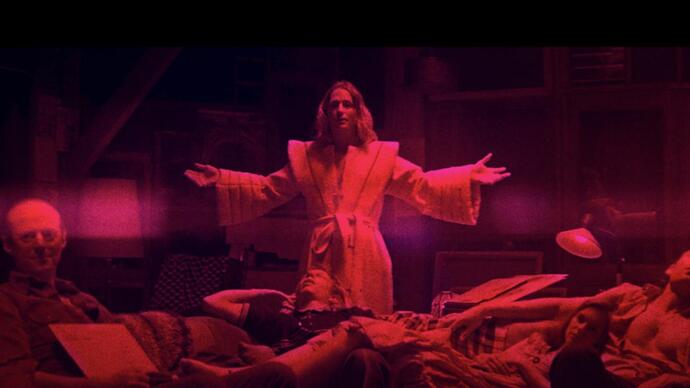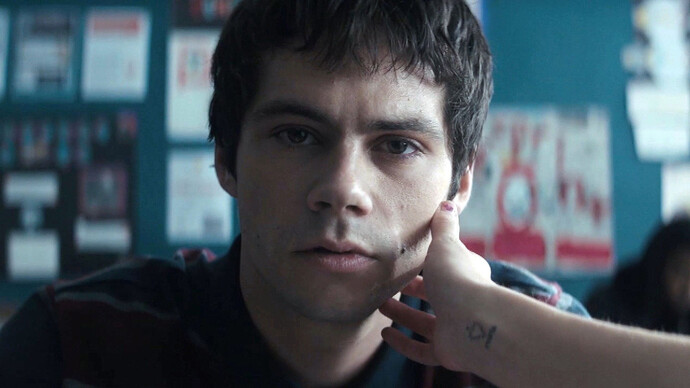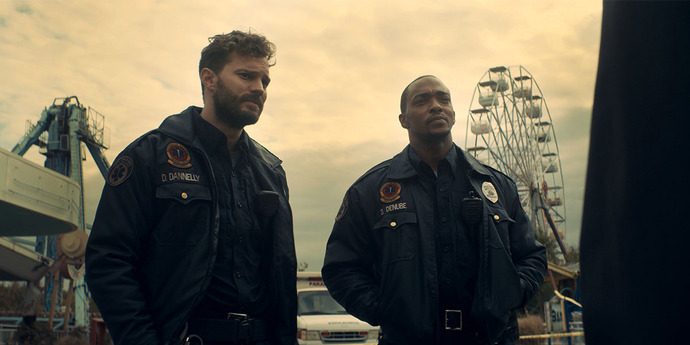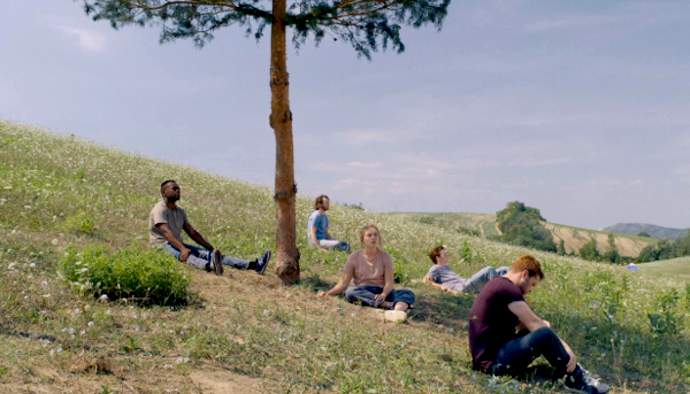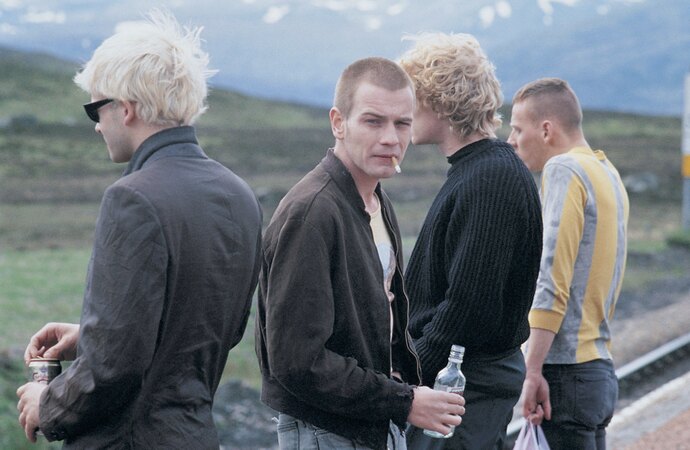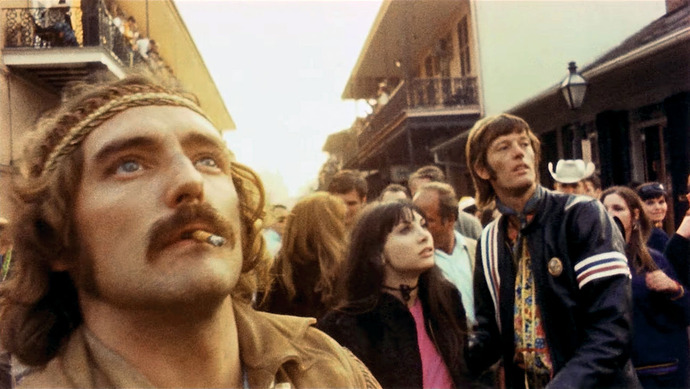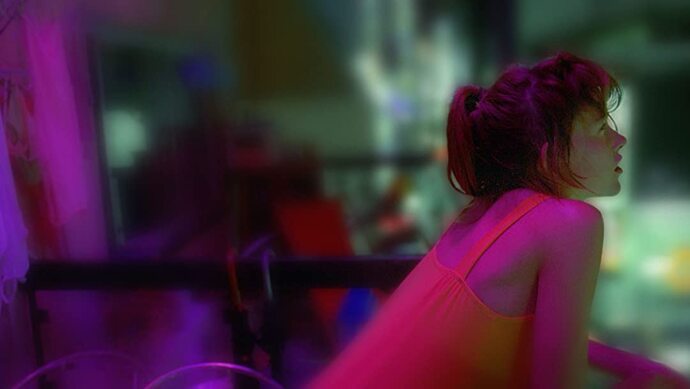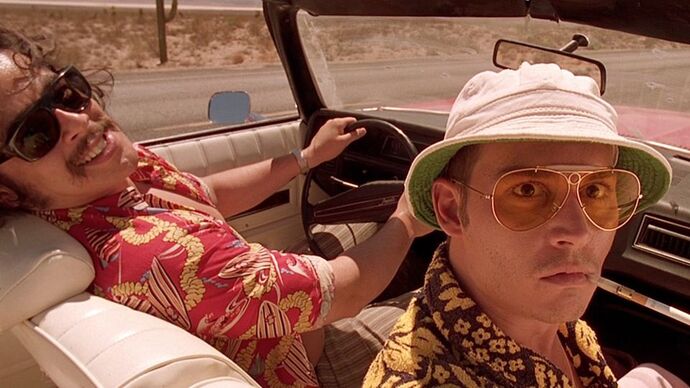Drug abuse isn’t exactly a new topic when it comes to film exploration, but most movies simply show us the character taking drugs. We rarely get to experience the drug in the character’s shoes. That’s why we’ve compiled a list of fascinating movies that take us into the minds of drug-using characters, to witness their distorted worlds from their skewed points of view. Here are some of the most trippy drug movies that depict the drug experience via clever cinematography and editing.
8. Mandy (2018)
Psychedelics can lead to fun mind-expanding experiences that open gateways into whole new worlds. But they can also be traumatic. Panos Cosmatos’s psychedelic horror Mandy is like a slice of fantasy art come to life. Red saturates the screen in violent symbolism, and everything is lucid. Nicolas Cage stars as (aptly named) Red Miller, who’s out for revenge when a demonic cult kidnaps his wife. Mandy is savage and brutal, but artistically astounding. Everything is smoky, dark, and distorted. The screen is hyper-stylized with flashing satanic images and colored fog. Potent liquid LSD gives the biker gang sadomasochistic desires, and seductive folk music lures the titular Mandy―and us―into the commune. Red consumes tainted acid mixed with cocaine, and severely hallucinates… which we watch first-hand.
7. Flashback (2020)
Some find Flashback (originally The Education of Frederick Fitzell) frustrating to watch, as the plot can be a little difficult to follow. The second you think you know what’s going on, it slips away again. However, this is simply the nature of its fictional drug, so you’re experiencing time in the same fractured way that Frederick (played by Dylan O’Brien) does. Which, in our opinion, is pretty neat. Christopher MacBride directs this Canadian mystery thriller, where a dangerous new drug called “mercury” runs rife through a high school, but everyone’s memory of it is hazy. As it turns out, mercury frees its user from being “trapped” in time. When Frederick―now an adult―begins having horrible visions of a missing girl, he starts to piece the past back together. In a tangle of flashbacks and memories and timelines, a strange boy speaks to him in disjointed riddles as he figures out what’s going on.
6. Synchronic (2019)
Directed by Justin Benson and Aaron Moorhead, Synchronic features an imaginary time-bending designer drug. In this movie, the pineal gland is where the “third eye” is located, and the calcification of it (due to age or fluoride consumption) limits our ability to ascend and experience higher consciousness. A new drug named “synchronic” alters its user’s perception of time via the pineal gland—and teenagers are more susceptible than adults. Dennis (played by Jamie Dornan) and Steve (played by Anthony Mackie) are two paramedics who are called out to bizarre emergency scenes across New Orleans. Victims have been inexplicably injured, and under-the-influence witnesses babble incoherently. When Dennis’ daughter Brianna (played by Ally Ioannides) goes missing, Steve takes on the investigation by himself. Steve’s cancer renders his pineal gland underdeveloped, so he’s able to explore the effects of synchronic more accurately. The drug allows Steve to travel back in time for seven minutes. But here’s the catch: when you take it, your location determines what era of time you’ll be sent to. Steve goes to the Ice Age, warzones and swamps, chased by the Conquistador and Ku Klux Klan. He records and maps out his findings in order to find Brianna, who’s trapped on the shores of the Mississippi River during the War of 1812.
5. Midsommar (2019)
Midsommar isn’t a film about drugs per se, but drugs certainly feature. Ari Aster’s stunning flick received knock-out reviews, delivering an uncannily bright and trippy version of the horror genre. Most horrors are filmed in the shadows, desaturated in darkness, with the odd bit of candlelight. Midsommar, however, takes place on the rolling hills of Sweden where the sun shines, flowers grow, and it always seems to be daytime. Dani Ardor (played by Florence Pugh) attends a midsummer celebration in rural Hälsingland with her boyfriend Chris (played by Jack Reynor). She’s hesitant at first, but comes to try and strengthen their waning relationship. Upon arrival, the guests are given magic mushrooms—and Dani has a bad trip, and we get to live that bad trip through her eyes. The screen melts and pulsates, but subtly enough for it to remain realistic. This introduces the psychedelic elements that would appear later on. Aster clearly drew on his own experiences of the drug (which, he reassures in interviews, have always been positive), enabling us to enter that psilocybin headspace more believably.
4. Trainspotting (1996)
Director Danny Boyle is known for his surreal dreamscapes. Whether that’s the starvation-induced hallucinations in 127 Hours or the depiction of drug culture that had The Beach banned in Thailand, Boyle loves to get a little weird. His most loved movie, Trainspotting, is no exception. Following a group of heroin addicts, this black-comedy is filled with nightmarish scenes from the characters’ points of view. Right off the bat, we’re met with the “Worst Toilet in Scotland” (an understatement). Mark Renton (played by Ewan McGregor) crawls through the revolting toilet seat and into the ocean to retrieve opiates. Later, we see a baby crawling on the ceiling when Renton’s parents force him to go cold-turkey. The infant’s head spins 180 degrees, and we witness the horrors of withdrawing from class-A drugs. Trainspotting is littered with these dark, illusionary sequences. The cult classic famously depicts the lifestyle of an addict first-hand, acting a as a social commentary on urban poverty in Edinburgh.
3. Easy Rider (1969)
Easy Rider marked the dawn of New Hollywood, effectively ending the cycle of studio-produced films from the Golden Age of Hollywood. The indie flick was revolutionary for its time, shot on location with no censorship on drug use. Dennis Hopper’s road movie follows two motorcyclists smuggling cocaine from Mexico to LA. On the way, they smoke a lot of weed and pick up a hippie hitchhiker, who invites them to a “free love” commune. As a pinnacle movie of the 1960s, there’s bound to be a lot of psychedelics. In one scene, they take a load of LSD and trip out in a graveyard. Again, we don’t simply watch the scene but participate in it through Hopper’s creative use of the film medium. Quick cutting, tilted camera angles, lens flares, zooms, and erotic imagery disrupt the otherwise steady pace, signaling the switch from sanity to (temporary) insanity.
2. Enter the Void (2009)
Enter the Void, directed by Gaspar Noé, experiments with what film can artistically achieve. Set among the blinding neon lights of Tokyo, the drama is shot from a first-person POV. Noé describes his movie as a “psychedelic melodrama,” unfolding from the out-of-body experience of Oscar (played by Nathaniel Brown). After being shot by police for selling drugs, Oscar watches his own body from above. A non-chronological account of his life ensues, and he floats along the skies of the city in limbo between life and death. DMT plays a huge role in Enter the Void, alongside depictions of the afterlife (mainly from a Buddhist perspective). As the entire film is shot from Oscar’s viewpoint―either through his eyes or over his shoulder―we are placed fully in his shoes. The screen blacks out when he does. We hear his private internal thoughts. We see his DMT-induced hallucinations. It’s bold, trippy, and an utter cinematic marvel.
1. Fear and Loathing in Las Vegas (1998)
The fact that Fear and Loathing in Las Vegas is based on a true story? Nothing short of a miracle. The amount of substances consumed by Raoul Duke (played by Johnny Depp) and Dr. Gonzo (played by Benicio del Toro) on their road trip across Nevada should have been fatal. But alas, Hunter S. Thompson (whom the film is based on) made it out alive enough to write his experiences into a novel. Mescaline, diethyl ether, alcohol, LSD, cannabis―you name it, they take it. It all results in a torpedo ride of a movie. Director Terry Gilliam mirrors the duo’s frantic state with frantic filmmaking, cutting fast between takes, and invasively close-up camera work. The dialogue is quick and exaggerated. Everything is turned upside down. The story is somewhat aimless and devoid of character development―but that’s not the point. The point is to take the audience on a crazy, drug-fueled ride of Sunshine Acid, fast cars, and frantic psychosis, which Gilliam certainly achieves.

